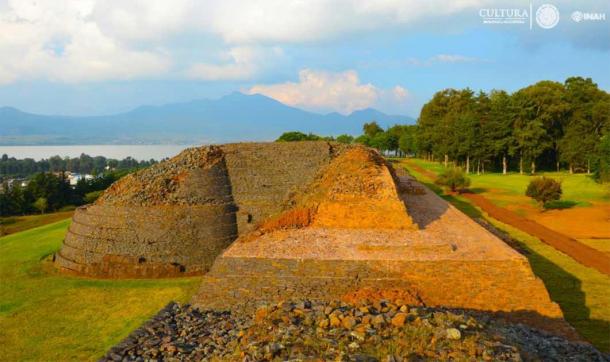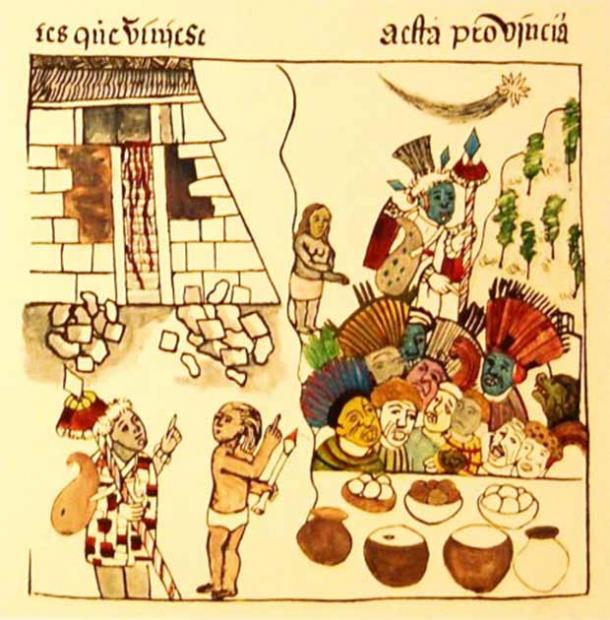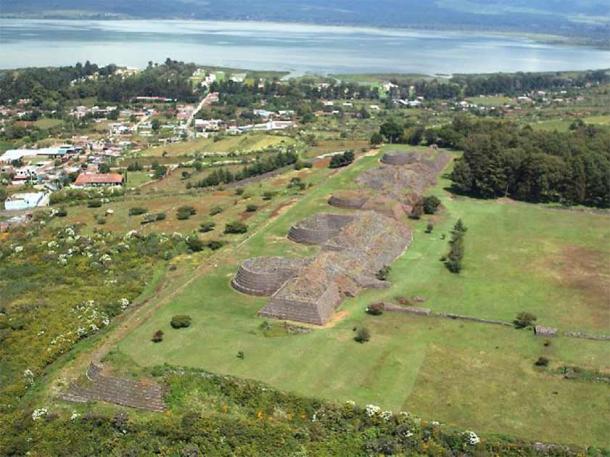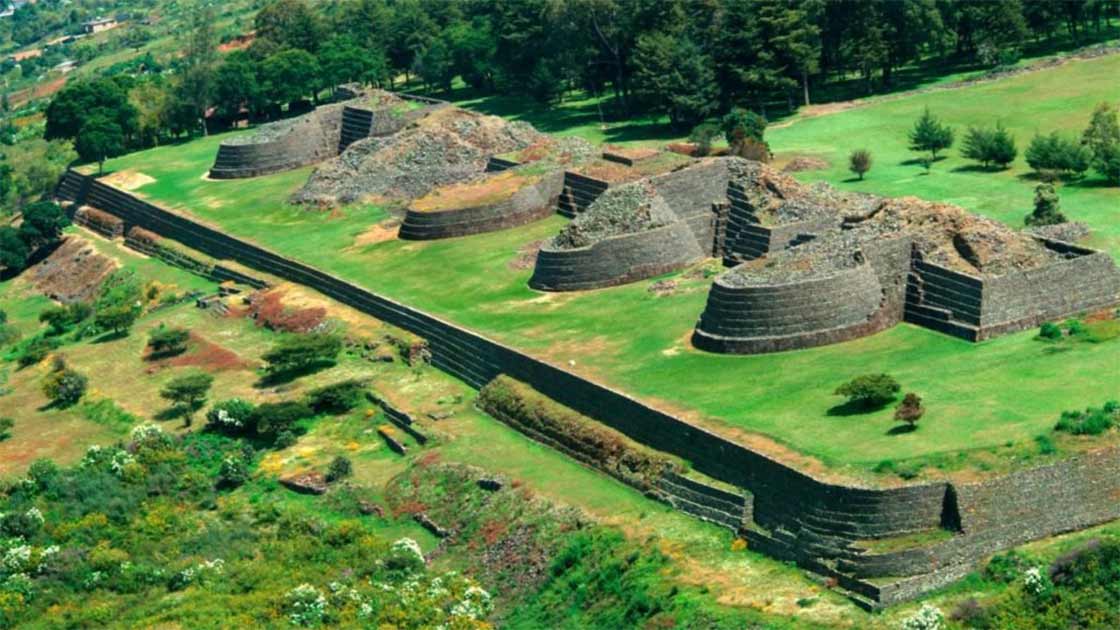The Pyramids of Tzintzuntzan: Vestiges of the Purépecha Empire
On the banks of Lake Pátzcuaro in Mexico, the stone ruins of Tzintzuntzan pay homage to the great capital of the pre-Columbian Purépecha civilization which existed from the 14th to the 16th century. What secrets are contained within the partially excavated rubble?

Detail of the Tzintzuntzan pyramid structures with Lake Pátzcuaro in the background. (INAH)
The Tzintzuntzan Ruins: Stones Revealing Their Secrets
Once the heart of the Purépecha Empire, the Lake Pátzcuaro basin is home to the ancient remains at Tzintzuntzan, which became the center of power for the Purépecha in the 15th century. The name itself comes from the Purépecha Ts’intsuntsani, which translates to mean “place of hummingbirds”. When the Spanish arrived in the 1520s the town is said to have had a population of about 30,000 people.
All but forgotten, excavations began in the 1930s and, so far, only about 35% of the site has been excavated. Over the decades, archaeologists have attempted to understand and conserve the history and magnificence of the enormous platform built into Tahuarato hill measuring 450 by 250 meters (1476 ft by 820 ft), on which five yácatas, or rounded pyramids, can still be seen today.
- Will Pope Apologize to Mexico for Church Complicity during Spanish Conquest?
- The Aztec Map of Cuauhtinchan And The Hidden Pyramid of Teoton
The Tzintzuntzan pyramids were built up and covered in decorated stones. There is evidence to suggest these were painted red, according to the Instituto Nacional de Antropologia e Historia. To date only two of the three pyramids have been reconstructed. On top of these pyramids were wooden buildings for performing important ceremonies such as burials.
The site enjoys strategic views over Lake Pátzcuaro and thus provided natural protection from invaders. The ceremonial site was the religious center for the Purépecha community. From here their ruler represented Curicaueri, their god of war, hunting and fire. Outside the yácatas, fires were maintained and sacrifices made to the gods. ADV Estudio have published a revealing recreation of how the site would have looked during its time.
Behind the yácatas was a zone reserved for the elite and their personal servants. Common people would not have had access, adding to the mysterious and powerful effect the structures would have had on those below, considered by some a type of psychological warfare. Excavations have also revealed older structures underneath the yácatas.

Image showing Purépecha priests besides a pyramid structure, such as the one at Tzintzuntzan. (Public domain)
Who Were the Purépecha?
The ancient Purépecha civilization existed in the modern Mexican state of Michoacán, as well as sections of Guanajuato and Jalisco. Founded at the start of the 14th century, the Purépecha civilization was contemporary to the Aztecs, and blocked their expansion into the area. They were in fact the second largest empire in Mesoamerica at that time, a fact that only recently has been recognized.
The Purépecha and their very distinctive culture were governed by a cazonci ruler, and Tzintzuntzan was their capital city, said to have been founded by Tariácuri. The history of the Purépecha has been gleaned, in part, thanks to the illustrated Relación de Michoacán, written in 1540 by Fray Jeronimo de Acalá, a Franciscan priest, along with several other Spanish sources. The Purépecha themselves did not leave any written records behind.
The ancient text claims that the Purépecha civilization was brought about by Tariácuri, who brought together the many different peoples living around Lake Pátzcuaro into a centralized state. He then created three cities, Pátzcuari, Ihuatzio and Tzintzuntzan, the latter two governed by his two nephews Hiripan and Tangáxoan.

Arrival of the Spanish to Michoacán in Relación de Michoacán. (Public domain)
Spanish Conquest of Tzintzuntzan and the Purépecha Empire
In the 1520s, the Purépecha faced a difficult decision. Having heard of the fall of the Aztec Empire to the Spanish, their leader Tangáxuan II, the last of the cazonci, cooperated with the Spanish and was therefore given a comparatively large amount of autonomy. This wasn’t to last long however.
- Enormous Ancient Building Identified Beneath Monte Albán’s Main Plaza
- Were Mexico’s Circular Pyramids Really Made for a Flying Ceremony?
On February 14, 1530, Nuño de Guzmán, a famously cruel and ruthless conquistador, had Tangáxuan II tortured and executed. After this, the Spanish attempted to govern the area with a series of puppet rulers, but in the end Tzintzuntzan was destroyed. Its magnificent constructions were dismantled and used as building materials for Spanish constructions, a cruel and effective tactic of erasure used by the Spanish throughout their pillage and conquer of South America.

Aerial view of Tzintzuntzan. (Latin American Studies)
Visiting Tzintzuntzan
The archaeological ruins are open from Monday to Sunday from 9.00 to 18.00 and cost 65 pesos (about $3.20). They are located just under an hour by car from Morelia, to the north of the town of Tzintzuntzan. There is also a museum, the Museo de Sitio de la Zona Arqueológica de Tzintzuntzan, which exhibits artifacts and remains found at the site, as well as giving an overview of the history of the Purépecha capital at Tzintzuntzan in Mexico. The site hosts end of year celebrations where indigenous communities show off their particular culture and dances.
Top image: The ruined pyramids at Tzintzuntzan. Source: Secretaría de Turismo de Michoacán
By Cecilia Bogaard
References
INAH TV. 2020. “Tzintzuntzan, Michoacán, en la Lotería Nacional” in YouTube. Available at: https://www.youtube.com/watch?v=et6cr9Yz5t0
INAH TV. 2020. “Michoacán, el reino inconquistable” in YouTube. Available at: https://www.youtube.com/watch?v=flZ7GF3CcpY
INAH. 2020. “Zona Arqueológica de Tzintzuntzan” in Instituto Nacional de Antropologia e Historia. Available at: https://www.inah.gob.mx/zonas/179-zona-arqueologica-de-tzintzuntzan
No name. 2020. “Tzintzuntzan” in SIC Mexico: Sistema de Información Cultural. Available at:
https://sic.cultura.gob.mx/ficha.php?table=zona_arqueologica&table_id=61


















Comments
Interesting article. Thanks. However, I cannot help pointing out that it’s pre-Columbian, not pre-Colombian. It’s a very common error.